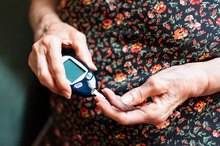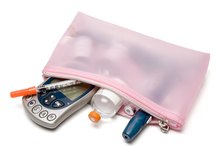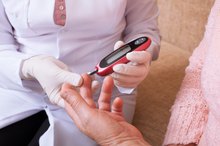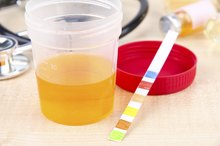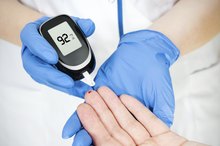What does fact checked mean?
At Healthfully, we strive to deliver objective content that is accurate and up-to-date. Our team periodically reviews articles in order to ensure content quality. The sources cited below consist of evidence from peer-reviewed journals, prominent medical organizations, academic associations, and government data.
The information contained on this site is for informational purposes only, and should not be used as a substitute for the advice of a professional health care provider. Please check with the appropriate physician regarding health questions and concerns. Although we strive to deliver accurate and up-to-date information, no guarantee to that effect is made.
What Is a High Blood Glucose Reading?
According to the American Diabetes Association, more than 23 million Americans have diabetes, with another 57 million in the stage known as prediabetes. Diabetes results from the body’s inability to process sugar in the bloodstream, and can lead to major health problems and even death if untreated. One of the ways to detect diabetes is through blood glucose readings.
Blood Sugar and Insulin
When you eat anything containing carbohydrates, the digestion process passes glucose into the bloodstream. The pancreas produces a hormone called insulin, which takes this glucose to the body’s organs for use as fuel. The more sugar that exists in the bloodstream, the more insulin the pancreas will produce to utilize it.
Insulin Problems
Blood Sugar Imbalance Symptoms
Learn More
Problems with blood sugar levels can happen for a number of reasons. The pancreas might not produce enough insulin to remove glucose from the blood, leading to an excess in the bloodstream. A diet that is high in carbohydrate can also force the pancreas to overproduce insulin to the point where cells develop a resistance against its effects. Doctors can diagnose these conditions by measuring blood glucose under specific circumstances. Blood tests measure glucose levels in milligrams per deciliter.
- Problems with blood sugar levels can happen for a number of reasons.
- The pancreas might not produce enough insulin to remove glucose from the blood, leading to an excess in the bloodstream.
Fasting Glucose
The preferred test for measuring blood sugar is the fasting blood glucose test 2. This is a test administered first thing in the morning, after at least eight hours of fasting, to prevent any lingering glucose from a recent meal. According to the National Diabetes Information Clearinghouse, any measurement over 125 mg/dL is an indicator of diabetes and will require treatment.
Post-Meal Measurement
What Does It Mean if Sugar Is High in Your Urine but Not in Your Blood?
Learn More
Another method of measuring blood glucose tests the body’s ability to utilize sugar after a meal. Taking a reading two hours after a meal can give you an idea of how your body processes glucose and if there is any insulin resistance present. In the clinical setting, an oral glucose tolerance test involves drinking a solution of 75g of sugar dissolved in water and checking blood levels two hours later 2. In these tests, any reading above 200mg/dLr is an indicator of diabetes, according to the National Diabetes Information Clearinghouse.
- Another method of measuring blood glucose tests the body’s ability to utilize sugar after a meal.
- In the clinical setting, an oral glucose tolerance test involves drinking a solution of 75g of sugar dissolved in water and checking blood levels two hours later 2.
Prediabetes
Even if your blood glucose levels do not indicate diabetes, NDIC states that elevated numbers can be a sign of problems down the road. If your fasting glucose levels are between 100 mg and 124 mg/dL, it is an indicator of impaired fasting glucose, indicating a problem with your body’s ability to metabolize glucose over long periods. A post-meal reading of 140 to 199 mg/dL is an indicator of impaired glucose tolerance, a resistance to insulin in the blood. Either of these conditions can develop into full diabetes if not treated.
- Even if your blood glucose levels do not indicate diabetes, NDIC states that elevated numbers can be a sign of problems down the road.
- If your fasting glucose levels are between 100 mg and 124 mg/dL, it is an indicator of impaired fasting glucose, indicating a problem with your body’s ability to metabolize glucose over long periods.
Related Articles
References
- Endocrineweb: Diagnosing Diabetes
- Medline Plus: Glucose Test--Blood
- National Institute of Diabetes and Digestive and Kidney Diseases. Diabetes diet, eating, & physical activity. Published December 2016.
- American Diabetes Association. The big picture: Checking your blood glucose.
- American Diabetes Association. 6. Glycemic Targets: Standards of Medical Care in Diabetes-2020. Diabetes Care. 2020;43(Suppl 1):S66-S76. doi:10.2337/dc20-S006
- American Diabetes Association. 14. Management of diabetes in pregnancy: Standards of medical care in diabetes-2020. Diabetes Care. 2020;43(Suppl 1):S183-S192. doi:10.2337/dc20-S014
- Porcellati F, Lucidi P, Bolli GB, Fanelli CG. Thirty years of research on the dawn phenomenon: Lessons to optimize blood glucose control in diabetes. Diabetes Care. 2013;36(12):3860-2. doi:10.2337/dc13-2088
- American Diabetes Association. 5. Lifestyle management: Standards of medical care in diabetes-2019. Diabetes Care. 2019;42(Suppl 1):S46-60. doi:10.2337/dc19-S005
- Colberg SR, Sigal RJ, Yardley JE, et al. Physical activity/exercise and diabetes: A position statement of the American diabetes association. Diabetes Care. 2016;39(11):2065-2079. doi:10.2337/dc16-1728
- American Diabetes Association (ADA). Understanding A1C.
- Garber AJ, Abrahamson MJ, Barzilay JI, et al. Consensus statement by the American association of clinical endocrinologists and American college of endocrinology on the comprehensive type 2 diabetes management algorithm - 2019 executive summary. Endocr Pract. 2019;25(1):69-100. doi:10.4158/CS-2018-0535
Writer Bio
Milton Kazmeyer has worked in the insurance, financial and manufacturing fields and also served as a federal contractor. He began his writing career in 2007 and now works full-time as a writer and transcriptionist. His primary fields of expertise include computers, astronomy, alternative energy sources and the environment.

